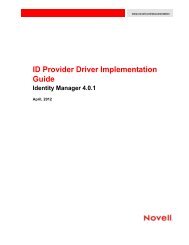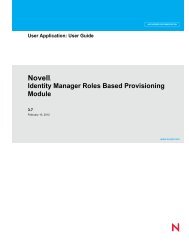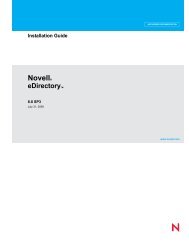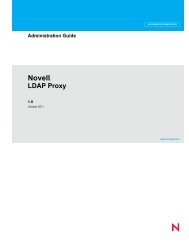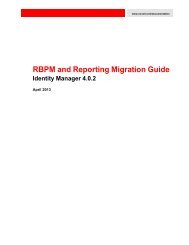Identity Manager 4.0.1 Driver for Scripting Implementation ... - NetIQ
Identity Manager 4.0.1 Driver for Scripting Implementation ... - NetIQ
Identity Manager 4.0.1 Driver for Scripting Implementation ... - NetIQ
Create successful ePaper yourself
Turn your PDF publications into a flip-book with our unique Google optimized e-Paper software.
3 Accept the default installation folder or specify your own. Click Next to continue.<br />
4 Review your settings and click Next to continue.<br />
5 After the driver files are copied, you are prompted to retrieve an SSL certificate. Novell<br />
eDirectory must be running to retrieve the certificate. The certificate allows SSL encryption<br />
between the <strong>Identity</strong> <strong>Manager</strong> engine and the driver shim. Enabling SSL is optional but is<br />
recommended <strong>for</strong> better security. To retrieve the certificate, click Yes and follow the prompts in<br />
the console window:<br />
5a Specify the DNS name or IP address of your eDirectory server.<br />
5b Specify the LDAP secure port, default 636.<br />
5c Enter Y to accept the certificate.<br />
6 You are prompted to enter <strong>Driver</strong> and Remote Loader passwords. These passwords are used to<br />
verify that an authorized driver shim is communicating with the <strong>Identity</strong> <strong>Manager</strong> engine.<br />
Although you don’t need to enter the passwords immediately, they must be set at some point<br />
be<strong>for</strong>e running the driver. Click Yes to the prompt and follow the prompts in the console<br />
window:<br />
6a Enter and confirm the Remote Loader password.<br />
6b Enter and confirm the <strong>Driver</strong> password.<br />
7 The installation of the driver shim is finished, with the option of starting the <strong>Driver</strong> Shim<br />
Service. Proceed to the next section to complete the installation of the driver.<br />
3.2.2 Creating the <strong>Driver</strong> in Novell eDirectory<br />
1 In i<strong>Manager</strong>, click the Import <strong>Driver</strong>s task under <strong>Identity</strong> <strong>Manager</strong> Utilities.<br />
2 All drivers are contained in a driver set. You can create a new driver set or install the driver into<br />
an existing one. See “Creating and Configuring a <strong>Driver</strong>” in the <strong>Identity</strong> <strong>Manager</strong> 3.6.1<br />
Administration Guide <strong>for</strong> more details. Click Next to proceed.<br />
3 Select the <strong>Scripting</strong> driver from the list of drivers, then click Next to proceed.<br />
4 Fill in the requested configuration fields, then click Next to continue.<br />
When entering the Remote Loader and <strong>Driver</strong> Object passwords, be sure to enter the same<br />
values that you entered when installing the driver shim. For more in<strong>for</strong>mation on these fields,<br />
see Section 4.1, “<strong>Driver</strong> Parameters and Global Configuration Values,” on page 25.<br />
5 Click Define Security Equivalences, and select your administrative user to make the driver<br />
security-equivalent to that user (see also Section 2.3, “Establishing a Security-Equivalent<br />
User,” on page 17).<br />
6 Click Exclude Administrative Roles, and select your administrative user and other highprivilege<br />
users that should not be included monitored <strong>for</strong> events.<br />
7 Click Next to proceed, then click Finish to complete the installation.<br />
3.2.3 Running the <strong>Driver</strong><br />
Start the driver engine component in Novell i<strong>Manager</strong>.<br />
The driver shim is a Windows service. Use the Windows Services application to start and stop the<br />
Novell <strong>Identity</strong> <strong>Manager</strong> Windows Script <strong>Driver</strong> service (see Chapter 6, “Using the <strong>Scripting</strong><br />
<strong>Driver</strong>,” on page 117).<br />
Installing the <strong>Scripting</strong> <strong>Driver</strong> 21








